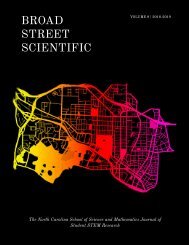Broad Street Scientific Journal 2020
You also want an ePaper? Increase the reach of your titles
YUMPU automatically turns print PDFs into web optimized ePapers that Google loves.
and chilled water was added by drop until crystals began
to form. Once this occurred, the beaker was carefully set
in ice and not disturbed to allow for crystallization to complete.
The crystals were collected by vacuum filtration
and dried. Thin layer chromatography (TLC) was used to
monitor the progress of the reaction.
in solution (1mM). The assay protocols were adjusted to
fill cuvettes for analysis by fluorescence emission in a spectrophotometer.
Four solutions were prepared and tested using the above
assays. A solution with the GSK-3β enzyme, but no ATP
or inhibitor, was used to create the lower boundary for
expected fluorescence. A solution with ATP, but no GSK-
3β or inhibitor, determined the upper boundary with the
greatest amount of ATP to be expected. Next, a solution
with the enzyme and ATP, but no inhibitor, showed the
regular activity of GSK-3β. Lastly, all three components
were put in the solution to find the impact of the inhibitor
on GSK-3β activity. The % inhibition was calculated for
the specific inhibitor concentration.
3. Results and Discussion
3.1 – Computational Analysis
Molegro Computational Analysis showed a clear increase
in predicted inhibition when the substituents with
the suggested properties were added. The adapted molecules
have better predicted binding affinities compared to
the Model 30 structure (Fig. 6). The more negative scores
suggest a better inhibition for the GSK-3β enzyme.
Figure 5. Respective R-groups for the proposed synthesis
procedure.
Fourier-transform infrared spectroscopy (FTIR) was
then used to determine whether the inhibitor was in fact
created. Heptane, ethyl acetate, and chloroform were unable
to sufficiently dissolve the product for liquid FTIR,
so KBr pellets were created to run FTIR. Since KBr pellets
are susceptible to water vapor, the crushed inhibitor
was mixed with uncrushed KBr before being compressed.
A blank KBr pellet was used as the background to further
reduce the influence of the O-H bond of water on the resulting
graph. FTIR graphs from the reactants and the
product were compared to determine whether the reaction
occurred correctly.
2.3 – Assay to Test GSK-3β Inhibition
The BioVision ATP Colorimetric/ Fluorometric Assay
Kit was paired with the BPS Bioscience GSK-3β Assay Kit
to determine the molecule’s inhibitory effect on the GSK-
3β protein by inducing measurable fluorescence. Properly
functioning GSK-3β consumes ATP in its reaction with a
substrate, so inhibited GSK-3β would leave high ATP levels.
Since the measured fluorescence directly corresponds
to the amount of ATP left in solution, inhibition can be
tested by measuring fluorescence of the solution.
To prepare the product for the assays, just enough dimethyl
sulfoxide (DMSO) was added to dilute the product
Molecule
Inhibitor Binding Affinities
Binding
Affinity
Model 30 -27.886
Molecule
Binding
Affinity
T002052 -30.7393 PyrroleC 3
O 2
-31.7228
T006129 -31.1837 PyrroleNH 2
-29.5741
T010305 -33.3667 T01113w/
OCH 3
-29.3512
Figure 6. Molegro computational binding affinities
for Model 30 and six candidate inhibitors.
With these promising computational inhibition results,
these six candidate compounds were imported into
StarDrop to assess suitability in medical application. The
Lipinski Rule of Five and the Oral CNS Scoring Profile
data were compared between molecules. The compounds
seem to be viable in most of the metrics computed by
StarDrop. See the StarDrop Data in Supplemental Materials,
below. Between molecules, the most variation is
with respect to the blood brain barrier permeability (BBB
log([brain]:[blood])). Compounds with more positive BBB
values can penetrate the BBB more easily, increasing their
efficacy in reaching the target site in the brain and, therefore,
requiring a lower dosage. Disappointingly, when
comparing the BBB permeability to the binding affinity
scores (Fig. 7), there were few compounds that noticeably
stood out from the rest in both areas.
48 | 2019-2020 | Broad Street Scientific CHEMISTRY




